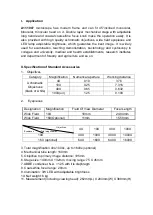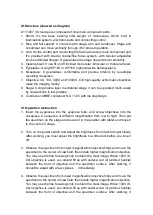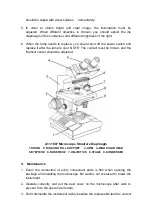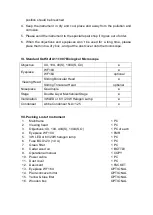
III. Structure (showed as diagram)
A11.1007 microscope is composed of nine main component parts:
1.
Stand: It’s the base bearing total weight of microscope, which built in
illumination system, electronic parts and connecting control.
2. Rise and fall support: It connects with stage, arm and condenser. Stage and
condenser can move vertically through it for proper operation.
3.
Arm: It’s the central part connecting the frame and every main component part.
It’s provided with coaxial coarse/fine focus system, with tension adjustable
knob and limited stopper. It guarantees the stage rise and down smoothly.
4. Viewing head: It can fit on 45°inclined monocular, binocular, or trinocular head.
5. Eyepieces: Using WF10X or WF16X (optional) wide field eyepiece.
6. Nosepiece: It guarantees comfortable and precise rotation by quadruple
revolving nosepiece.
7. Objective: 4X, 10X, 40(S) and 100X(S, Oil) high-quality achromatic objectives
make the imaging clearly.
8. Stage: Using double layer mechanical stage, it can be operated much easily
by coaxial knob in low position.
9. Condenser: ABBE condenser N.A =1.25 with iris diaphragm.
IV. Operation Instruction
1. Insert the eyepieces into the eyepiece tube, and screw objectives into the
nosepiece in sequence of different magnification from low to high. Then put
the specimen on the stage and secure it in the position with tablet and move it
to the center of stage.
2. Turn on the power switch and adjust the brightness from dark to bright slowly.
After working, you must adjust the brightness to a little dark before you tune it
off.
3. Observe the specimen from lower magnification objective firstly and move the
specimen to the center of view field, then rotate higher magnification objective.
You may use the fine focusing knob to obtain the clear image. When 100X (S,
Oil) objective is used, you should fill up with cedar wood oil (without bubble)
between the front of objective and the specimen surface. After working, it
should be wiped with a few xylenes immediately.
4. Observe the specimen from lower magnification objective firstly and move the
specimen to the center of view field, then rotate higher magnification objective.
You may use the fine focusing knob to obtain the clear image. When 100X (S,
Oil) objective is used, you should fill up with cedar wood oil (without bubble)
between the front of objective and the specimen surface. After working, it














